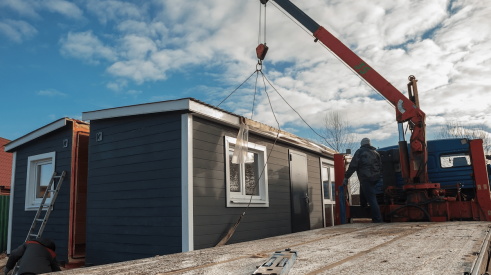You don't have to wait for houses that grow from seedlings and recycle themselves — the Partnership for Advancing Technology in Housing (PATH) has released its list of Top 10 Technologies for 2007. These 10 technologies are on the market today, just waiting to improve the durability, efficiency, affordability and environmental performance of the homes you build.
- Mold-Resistant Gypsum
"Moisture-resistant drywall has been designed so if it gets wet, it won't support mold growth," says Dana Bres, research engineer with PATH. "If a home has excess humidity or there's a flood, there will be problems to deal with, but mold in the drywall won't be one of them."
Cost: Moisture-resistant gypsum board costs 30 to 50 percent more than traditional drywall. Many builders use it in bathrooms, kitchens and exterior basement walls, but if you're building in a flood-prone area, you may want to use it more. - Solar Water Heater
Solar water heaters have been commercially available since the 1800s, and they're still an environmentally sound way to reduce energy bills. Now with federal tax credits through Dec. 31 equal to 30 percent of the installed cost, they are a more affordable option.
Cost: An active, flat-plate system costs about $2,500 to $3,500 installed and heats about 80 to 100 gallons of water a day. A passive system costs about $1,000 to $2,000 but holds less water. -
Induction Cooktops
In an induction cooktop, a magnetic field heats only the cooking container so food heats much faster. Induction cooktops can go from extremely low to extremely high settings and back again nearly instantly. Induction cooking is also about 30 to 40 percent more efficient than electric or gas, respectively.
Cost: A magnetic induction cooktop with four heating elements ranges from $1,800 to $4,000. - Combined Heat and Power (CHP)
CHP technologies have provided heat and electrical energy to commercial and industrial sites for years. Now they're available to homeowners who want to be off the grid or supplement their power. Units for the home range in capacity from 1 to 6 kW and are about the size of a water heater. They're also 50 to 60 percent more efficient than the local power plant.
Cost: A system with 1.2 kW of electrical generating capacity and 11,000 Btu heating capacity costs about twice that of conventional heating equipment. Consider sharing systems among multi-family homes and townhouse communities for a more economical approach. - Horizontal Axis Washer/Dryers
This two-in-one washer/dryer runs automatically from wash to dry: no more throwing clothes from one machine to the other. It runs quietly and requires no venting, so it can be installed almost anywhere. The high efficiency horizontal-axis washer reduces water and energy consumption, and the high RPM spin cycle means the dryer uses less energy to dry items.
Cost: Less than two separate units. The two-in-one retails for $900 to $1,100. - Hydrophilic, Impact-Resistant Windows
Now you can install self-cleaning, glare-reducing windows that also reduce the risk of window failure during tornadoes and hurricanes. The glass is laminated with composites strong enough to withstand high winds and projectiles.
Cost: Laminated safety glass adds about 50 percent to the cost of a typical 30-inch by 50-inch window. -
Super-Sized (Vertical) ICFs
Vertical ICF panels have all the energy efficiency, strength and building speed benefits of conventional ICF walls but go up faster and easier because fewer pieces are assembled on site. Because the wall sections are sturdier, they also require less bracing. Like their conventional counterparts, vertical ICFs provide outstanding disaster and sound resistance.
Cost: One manufacturer quotes $3 to $3.50 per square foot — comparable to other ICFs — but notes there are significant labor savings. - Permeable Pavers and Pavement
Rainwater seeps through permeable pavement systems and naturally filters through the soil instead of flowing off the lot. That means less unfiltered, nitrate-laden stormwater running off paved surfaces into rivers and streams. Translation: lower stormwater management costs for builders. Because engineered curb and gutter storm drainage systems are expensive to design and build, using permeable pavement systems instead can also reduce site development costs.
Cost: Roughly $1 to $4 per square foot. -
GPS for Land Development
This satellite-controlled software dramatically reduces labor and material costs by simplifying site grading. The software helps excavation machines cut and fill grade more efficiently and accurately and reduces the potential for soil erosion. The system consists of a digital 3-D model for the grade information and earthmoving equipment fitted with automatic computer-operated controls on the machine blade.
Cost: A system for one bulldozer costs about $100,000 to $125,000. - Recycled Concrete Substitutes and Admixtures
By-products of the industrialized world have found a better place in alternative concrete aggregate. Recycled materials such as granulated coal ash, blast furnace slag and various solid wastes such as fiberglass, glass and granulated plastics can substitute for sand, gravel and stones. Different admixtures can improve workability, temperature range, fire control, set time or color.
Cost: Mineral admixtures like silica fume sell for as much as $40 per cubic yard of concrete; corrosion inhibitors sell for about $30. On the low-end, water reducers cost $3 to $5 per cubic yard.Visit www.pathnet.org, then click on Tools, Tech Inventory, for detailed descriptions of each technology.
Federal Tax Credit Information: http://www.energystar.gov/index.cfm?c=products.pr_tax_credits
Author Information Susan Conbere writes about better building practices on behalf of the Partnership for Advancing Technology in Housing (PATH). PATH is administered by the U.S. Department of Housing and Urban Development. Learn more at www.pathnet.org. 
Advertisement
Related Stories
Off-Site Construction
Utah Passes Bill to Regulate Modular Construction at the State Level
Goals for housing innovation and affordability meet in the Utah's passage of a new bill that establishes a statewide modular construction program
Awards
Ivory Innovations Announces 25 Finalists for the 2024 Ivory Prize
The finalists for the prize demonstrate innovative, scalable solutions for advancing housing affordability
Business Management
AI in Home Building ... What Now? What Next?
Artificial intelligence is coming to home building. How can builders use AI in new-home construction? Start with this primer






